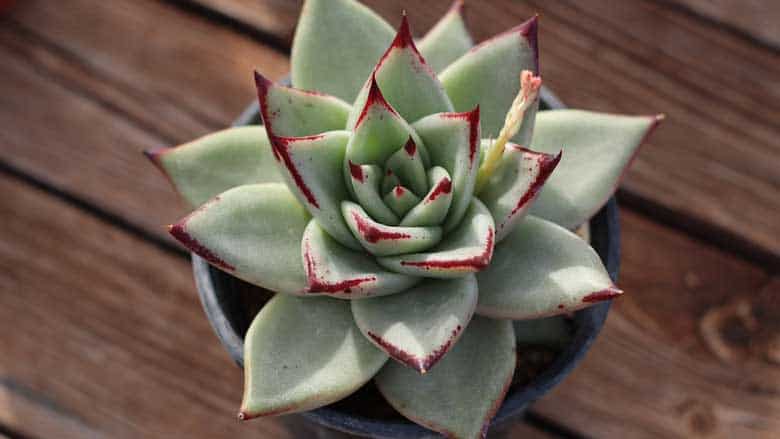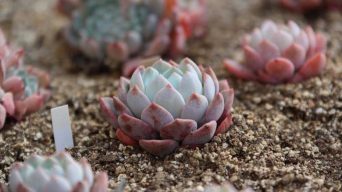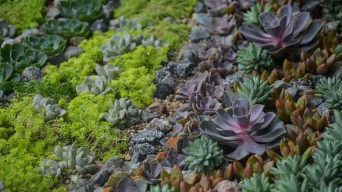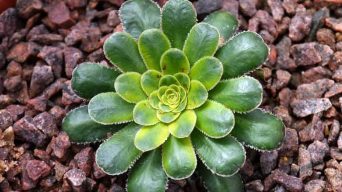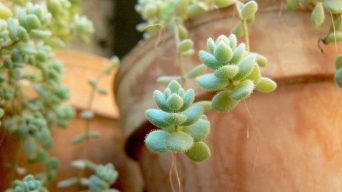Succulents are a great addition to any garden or home. They are easy to grow, look beautiful and come in many varieties.
They can be grown indoors or outdoors; they are easy to take care of and look beautiful in almost every environment.
Succulents are easy plants to propagate, and one of the easiest ways is by propagating succulent leaves.
But how do you start with nothing but leaves? How to propagate succulents from leaves?
It’s actually much easier than you think.
In this article, we will go over how to grow succulents from leaves so that you can have a gorgeous succulent garden in no time at all.
Best Types of Succulents To Grow From Leaves
There are many different types of succulents, and most of them can be grown from leaves.
However, some varieties are easier to grow than others.
Here are some of the best types of succulents to propagate from leaves:
Echeveria
The Echeveria genus is one that contains over 100 different species, all of which can grow from leaves.
This genus contains some of the most popular types of succulents, such as Echeveria lilacina, the Ghost Echeveria, and Echeveria agavoides.
Kalanchoe
The Kalanchoe is another excellent type that can grow from leaves into new succulent plants.
There are over 100 different species in this genus as well.
Some of the most popular types are Kalanchoe blossfeldiana and Kalanchoe tomentosa.
Sedum
A great option for someone who wants to start growing their own succulent plant from leaves is taking advantage of sedums!
They’re very hardy and can be grown in a variety of conditions.
Some popular types are Sedum morganianum, Sedum adolphii, and Sedum rubrotinctum.
Crassula
Crassula succulents are an excellent type for growing from leaves.
There are around 200 types of Crassulas, many of which can be grown from leaves.
Some popular types are Crassula ovata, Crassula cotyledonis, and Crassula capitella ‘Campfire’.
How To Propagate Succulents From Leaves
Propagating succulents from leaves is a simple process. There are a few steps to follow when growing succulents from leaves.
Follow these simple guidelines, and you’ll have plenty of new succulents in no time!
- Remove the leaves from the parent plant.
- Let them dry out for a few days to let the wound heal before planting.
- Root the leaves in soil or water
- Plant the rooted leaves in the soil once they have formed new roots
1. How To Remove Succulent Leaves
Removing leaves from succulents is a simple process. There are two main ways to do this: by hand or with shears.
Using our hands, we can easily pull the leaf off of where it meets the plant stem.
This method avoids cutting into the stem and damaging your succulents.
For larger leaves, using shears can be helpful to remove them.
Shears will let you get a clean-cut, so the leaf doesn’t tear and cause unsightly marks on your plant.
Just be very careful not to cut any part of the plant while doing so. If done correctly, none of these methods should cause significant damage to your succulents!
The best time to remove leaves from your succulents is in the spring, when new growth begins.
This will give your succulents time to grow new leaves before the hot summer hits.
Don’t wait until winter comes around, as it can cause significant damage during this time of year.
If done correctly and carefully, removing leaves from succulent plants is a simple process!
Just be patient and gentle with them, and they’ll reward you for years!
2. How to Callus Succulent Leaves
After removing succulent leaves, many people like to callus the plant’s cut-end before planting it.
The callus helps the cut ends heal faster and reduces moisture loss from occurring.
To callus succulent leaves, simply place the leaf in a dry spot for several days. Place them in a dry and shady area with good airflow to help speed up the process.
This will cause it to form its natural seal that won’t let any water or air into the plant, protecting it from rot and infection.
This process can take anywhere from a few days to over a week, depending on the size of the leaf and the temperature in your home.
If done correctly, you should have healthy succulent plants with no need to worry about rot or infection!
How To Tell if Succulent Leaf Is Calloused
When you know what to look for, it’s easy to tell if succulent leaves have been calloused and how well they’ve done so.
The most obvious sign is a dry brown outer layer that forms on the leaf cutting. This will protect your plant from rot and infection while protecting all of its moisture.
On larger leaves, you should also see a strong stem formed from the plant.
This is where new roots will start to grow before reaching out to whatever medium you choose to use.
Calloused leaves are an important part of succulent propagation as it helps your plants heal faster and prevents rot or infection!
In addition, callous can help speed up the process if you root your leaves in water and not soil!
3. How to Root Succulent Leaves
There are several ways you can root succulent leaves.
In general, the most popular way is by placing them in a container of soil and letting their roots grow from there! However, some people prefer rooting succulents in water instead.
Both methods have their pros and cons, but choosing the right method depends on what kind of succulent leaf you’re propagating!
How to Root Succulent Leaves in Soil
To root succulent leaves in soil, follow these simple steps:
Firstly, fill your container with a gritty and porous medium such as cactus potting soil. This will help ensure that your plant has proper drainage so it can retain water without drowning!
Second, lay the leaf on top of the dirt without burying it too deeply. Make sure the ends of the leaves don’t touch the soil!
Finally, you need to keep the potting soil moist. However, don’t let it get soggy, or else rot may occur!
Place your container in a warm and dry location with good airflow to help speed up the rooting process.
To tell if your succulent leaves are rooting properly, you should start to see small white roots pop up in several spots along with the leaves.
It can take anywhere from a few days to over two weeks for new root growth to show!
When done correctly, your succulent leaf should be rooted and ready to transplant into the soil.
How to Root Succulent Leaves in Water
Rooting succulent leaves in water is a great way to propagate them if they are extra sensitive! It’s also the most common method for leaf propagation.
To do this, place your cuttings into a glass of water and let their roots grow naturally from there!
Place them in bright, indirect sunlight to help speed up the process.
Make sure you change out the dirty old water for fresh, clean water every few days to keep the leaves healthy and moist.
It’s important that you don’t let your succulent leaves sit in dirty water for too long, or else they’ll drown!
The best way to tell if your succulent leaves are rooting properly is by starting to see small white roots.
It can take anywhere from a few days up to two weeks for the plant’s root system to grow!
When done correctly, you should have healthy succulents ready to be transplanted into the soil or an appropriate growing medium of their choosing.
4. How to Plant Succulent Leaves
Once you have your succulent leaves rooted and ready to grow, it’s time to plant them!
The best way is by using a potting mix that has the perfect balance of water retention while still having proper drainage. This will ensure that your succulent plants don’t drown or dry out too quickly.
Mix some cactus soil with perlite to help your succulent leaves retain water while not drowning.
You should only plant the leaf halfway into the soil and ensure that all cuttings face a similar orientation.
When you’re finished planting them, make sure to add potting mix around each one to cover up any exposed roots or stems!
Give your new succulent leaves some time to adjust to their new soil before adding any water.
It can take anywhere from a few days up to two weeks for the plant’s root system and leaves to settle in fully!
Properly caring for succulents after transplanting them is similar no matter what kind of cutting you’re growing.
Keep them in a warm and dry location with good airflow to help speed up the rooting process.
Ensure that you water them only when the soil is completely dry to ensure that you don’t drown them!
Make sure not to overwater them, or else root rot may occur!
Finally, make sure your succulent leaves get some bright, indirect sunlight to help them grow strong and healthy! They need at least six hours of sunlight a day.
If you’re propagating succulents inside, make sure they get a few hours of direct sunlight a day to help strengthen their stems and leaves.
As long as you’re taking proper care of your new succulent leaves, they should grow strong and healthy in no time.
When to Plant Succulent Leaf Cuttings
Succulent leaves are best planted in the early spring when the weather is cool.
Succulents will grow in the summer when it’s hot, but this can be not easy and is not recommended.
Succulent leaves should only be planted in the fall if you live somewhere where winter temperatures are mild.
You do not need to plant succulent leaves in the winter because they go dormant. Just let them be until springtime when it’s cool again!
What Is the Best Soil to Plant Succulents?
Succulents love soil that is fast draining, but it must retain moisture.
If you grow succulents indoors in pots or outdoors in the ground, use cactus or succulent potting soil for the best results.
A cactus soil mix will hold water but will also drain well. If you want to mix your own potting soil for succulents, it should be a blend of perlite and organic compost with some sand mixed in as well.
How Long Does It Take for New Succulent Plants To Grow?
New sprouts will appear within weeks after planting leaves, but they may need six months to mature into full-size succulent plants, depending on how large the leaf was originally.
The larger the original leaf, the longer it will take for the new plant to reach maturity.
Most succulents are slow-growing, so have patience!
How To Take Care of Propagated Succulents
Once you have propagated succulents, you need to care for them.
Succulents are plants that do not require much care, but you can do some easy things to make sure they grow healthy and well.
Water Them Regularly
Succulents require watering once a week but do not water the leaves as they can rot and die quickly if wet too often or for too long.
Instead, put your finger in the soil to see how moist it is, and only water when the soil is dry.
Also, make sure that you don’t overwater them or they can get root rot and die.
Provide the Right Amount of Sunlight
Succulents can live in many different places, but they do need sunlight to survive. Place them where there is plenty of natural light, and also make sure to rotate the plants every few days so that all sides are exposed equally.
Most succulents need bright, indirect light to grow well. They need at least four to five hours of bright sunlight every day.
It’s best if you can put them near a window with an eastern exposure, which means they get the most morning sun and less afternoon sun.
Although succulents like full sun, too much heat or light can cause their colors to fade or become bleached out.
Repot Them Every Few Years
Succulents will eventually outgrow their pots and will need to be repotted.
You’ll know it’s time to repot when the succulent starts to look cramped in its pot or when you see new growth appearing above the soil line.
Use a well-draining potting mix and make sure the new pot is only one size larger than the current one.
Transplanting succulents is best done in the spring or summer when they are actively growing.
Fertilize Them Once or Twice a Year
Succulent plants need very little fertilizer since they don’t have to grow large and use up nutrients quickly like other types of plants do.
Succulents only require feeding once every two months from spring until fall. Use an all-purpose plant food diluted by half for the best results.
Apply the solution to the soil and water it thoroughly.
If you follow these steps, your succulents will grow strong and healthy.
They’re very low-maintenance plants that don’t require much work!
Final Thoughts
Growing succulents from cuttings or leaves is a great way to get more of these beautiful plants for yourself.
Learning how to propagate succulent leaves is a simple process that just about anyone can do.
Some types of succulents are easier to grow from leaves than others, but most succulents can be grown in this way.
Before starting your project, make sure that the plant you are trying to propagate has not been sprayed with pesticides or fungicides.
These chemicals could affect any new growth coming off of the leaf-cutting.
Also, use sterilized soil when propagating succulents because non-sterile soils may contain fungus gnats which will attack newly planted succulents.
For best results, choose to propagate succulents during their spring or summer blooming season, so they have time to form roots before winter hits again!
Propagating succulents is a fun and easy way to get more succulents in your life, so give it a try today!

